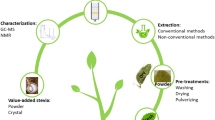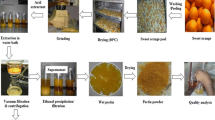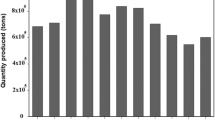Abstract
Bean cells habituated to grow in the presence of dichlobenil exhibited reduced cellulose and hemicellulose content and an increase in pectic polysaccharides. Furthermore, following the extraction of pectins and hemicelluloses, a large amount of neutral sugars was released. These sugars were found to be part of a soluble β-1,4-glucan in a preliminary characterization, as reported by Encina et al. (Physiol Plant 114:182–191, 2002). When habituated cells were subcultured in the absence of the herbicide (dehabituated cells), the release of neutral sugars after the extraction of pectins and hemicelluloses was maintained. In this study, we have isolated a soluble β-1,4-glucan from dehabituated cells by sonication of the wall residue (cellulose fraction) remaining after fractionation. Gel filtration chromatography revealed that its average molecular size was 14 kDa. Digestion of the sample with endocellulase revealed the presence of cellobiose, cellotriose, and cellotetraose. Methylation analysis showed that 4-linked glucose was the most abundant sugar residue, but 4,6-linked glucose, terminal arabinose and 4-linked galactose for xyloglucan, and arabinogalactan were also identified. NMR analysis showed that this 1,4-glucan may be composed of various kinds of substitutions along the glucan backbone together with acetyl groups linked to the OH group of sugar residues. Thus, despite its relatively high molecular mass, the β-glucan remains soluble because of its unique configuration. This is the first time that a glucan with such characteristics has been isolated and described. The discovery of new molecules, as this β-glucan with unique features, may help understand the composition and arrangement of the polymers within plant cell walls, contributing to a better understanding of this complex structure.




Similar content being viewed by others
Abbreviations
- DCB:
-
Dichlobenil
- XyG:
-
Xyloglucan
- snCR:
-
Supernatant of cellulose residue
References
Alonso-Simón A, Encina AE, García-Angulo P, Álvarez JM, Acebes JL (2004) FTIR spectroscopy monitoring of cell wall modifications during the habituation of bean (Phaseolus vulgaris L.) callus cultures to dichlobenil. Plant Sci 167:1273–1281
Alonso-Simón A, Neumetzler L, García-Angulo P, Encina AE, Acebes JL, Álvarez JM, Hayashi T (2010) Plasticity of xyloglucan composition in bean (Phaseolus vulgaris)-cultured cells during habituation and dehabituation to lethal concentrations of dichlobenil. Mol Plant 3:603–609
Álvarez JM, Encina A, García-Angulo P, Alonso-Simón A, Mélida H, Acebes JL (2012) Cellulose biosynthesis inhibitors as tools for research of cell wall structural plasticity. Nova Science Publishers, New York
Arioli T, Peng L, Betzner AS, Burn J, Wittke W, Herth W, Camilleri C, Höfte H, Plazinski J, Birch R, Cork A, Glover J, Redmond J, Williamson RE (1998) Molecular analysis of cellulose biosynthesis in Arabidopsis. Science 279:717–720
Arioli T, Burn JE, Williamson RE (2000) Molecular biology of cellulose biosynthesis. In: Jain SM, Minocha SC (eds) Molecular biology of woody plants, vol 1. Kluwer, Dordrecht, pp 205–226
Atalla RH (1998) Cellulose biosynthesis in Arabidopsis. Science 282:591
Carpita NC (2011) How plants make cellulose and other (1–4)-β-d-glycans. Plant Physiol 155:445–476
Carpita NC, Gibeaut DM (1993) Structural models of primary cell walls in flowering plants: consistency of molecular structure with the physical properties of the walls during growth. Plant J 1:1–30
Cavalier DM, Lerouxel O, Neumetzler L, Yamauchi K, Reinecke A, Freshour G, Zabotina OA, Hahn MG, Burgert I, Pauly M, Raikhel NV, Keegstra K (2008) Disrupting two Arabidopsis thaliana xylosyltransferase genes results in plants deficient in xyloglucan, a major primary cell wall component. Plant Cell 20:1519–1537
Cosgrove D (2005) Growth of the plant cell wall. Nat Rev Mol Cell Biol 6:850–861
De Leo G, Patricolo E, D’Ancona Lunetta G (1977) Studies on the fibrous components of the test of Ciona intestinalis Linnaeus. I. Cellulose-like polysaccharide. Acta Zool 58:135–141
DuBois M, Gilles KA, Hamilton JK, Rebers PA, Smith F (1956) Colorimetric method for determination of sugars and related substances. Anal Chem 28:350–356
Ebringerova A, Hromádková Z (2010) An overview on the application of ultrasound in extraction, separation and purification of plant polysaccharides. Cent Eur J Chem 8:243–257
Edelmann HG, Fry SC (1992) Effect of cellulose synthesis inhibition on growth and the integration of xyloglucan into pea internode cell walls. Plant Physiol 100:993–997
Encina AE, Moral RM, Acebes JL, Álvarez JM (2001) Characterization of cell walls in bean (Phaseolus vulgaris L.) callus cultures tolerant to dichlobenil. Plant Sci 160:331–339
Encina A, Sevillano JM, Acebes JL, Alvarez J (2002) Cell wall modifications of bean (Phaseolus vulgaris) cell suspensions during habituation and dehabituation to dichlobenil. Physiol Plant 114:182–191
Fry SC (2011) Cell wall polysaccharide composition and covalent crosslinking. In: Ulvskov P (ed) Plant polysaccharides: biosynthesis and bioengineering. Wiley-Blackwell, Oxford, pp 1–42
García-Angulo P, Willats WGT, Encina AE, Alonso-Simón A, Álvarez JM, Acebes JL (2006) Immunocytochemical characterization of the cell walls of bean cell suspensions during habituation and dehabituation to dichlobenil. Physiol Plant 127:87–99
García-Angulo P, Alonso-Simón A, Mélida H, Encina A, Acebes JL, Álvarez JM (2009) High peroxidase activity and stable changes in the cell wall are related to dichlobenil tolerance. J Plant Physiol 166:1229–1240
Guerreiro G, Fugelstad J, Bulone V (2010) What do we really know about cellulose biosynthesis in higher plants? J Integr Plant Biol 52:161–175
Haigler CH (1991) The relationship between crystallization and polymerization in cellulose biogenesis. In: Haigler CH, Wermer P (eds) Biosynthesis and biodegradation of cellulose. Marcel Dekker, New York, pp 99–124
Hakomori S (1964) A rapid permethylation of glycolipid, and polysaccharide catalyzed by methylsulfinyl carbanion in dimethyl sulfoxide. J Biochem 55:205–208
Hayashi T (1989a) Measuring β-glucan deposition in plant cell wall. In: Linkens HF, Jackson JF (eds) Plant fibers. Modern methods of plant analysis, New Series. Springer, Berlin, p 138
Hayashi T (1989b) Xyloglucans in the primary cell wall. Annu Rev Plant Physiol Plant Mol Biol 40:139–168
Hayashi T, Kaida R (2011) Functions of xyloglucan in plant cells. Mol Plant 4:17–24
Hon DNS (1994) Cellulose: a random walk along its historical path. Cellulose 1:1–25
Hughes J, McCully ME (1975) The use of an optical brightener in the study of plant structure. Biotech Histochem 50:319–329
Jarvis MC, Apperley DC (1990) Direct observation of cell wall structure in living plant tissues by solid-state 13C NMR spectroscopy. Plant Physiol 92:61–65
Lai Kee Him J, Chanzy H, Müller M, Putaux J-L, Imai T, Bulone V (2002) In vitro versus in vivo cellulose microfibrils from plant primary wall synthases: structural differences. J Biol Chem 277:36931–36939
Lane DR, Wiedemeier A, Peng L, Höfte H, Vernhettes S, Desprez T, Hocart CH, Birch RJ, Baskin TI, Burn JE, Arioli T, Betzner AS, Williamson RE (2001) Temperature-sensitive alleles of RSW2 link the KORRIGAN endo-1,4-β-glucanase to cellulose synthesis and cytokinesis in Arabidopsis. Plant Physiol 126:278–288
Murashige T, Skoog F (1962) A revised medium for rapid growth and bio assays with tobacco tissue cultures. Physiol Plant 15:473–497
Navarro DA, Cerezo AS, Stortz CA (2002) NMR spectroscopy and chemical studies of an arabinan-rich system from the endosperm of the seed of Gleditsia triacanthos. Carbohydr Res 337:255–263
Park YB, Cosgrove DJ (2012) A revised architecture of primary cell walls based on biomechanical changes induced by substrate-specific endoglucanases. Plant Physiol 158:1933–1943
Peng LC, Xiang F, Roberts E, Kawagoe Y, Greve LC, Kreuz K, Delmer DP (2001) The experimental herbicide CGA 325′615 inhibits synthesis of crystalline cellulose and causes accumulation of non-crystalline beta-1,4-glucan associated with CesA protein. Plant Physiol 126:981–992
Popper ZA, Fry SC (2008) Xyloglucan–pectin linkages are formed intra-protoplasmically, contribute to wall-assembly, and remain stable in the cell wall. Planta 227:781–794
Sandford PA, Conrad HE (1966) The structure of the Aerobacter aerogenes A3(S1) polysaccharide. I. A reexamination using improved procedures for methylation analysis. Biochemistry 5:1508–1517
Saxena IM, Brown RM (2005) Cellulose biosynthesis: current views and evolving concepts. Ann Bot 96:9–21
Thompson JE, Fry SC (2000) Evidence for covalent linkage between xyloglucan and acidic pectins in suspension-cultured rose cells. Planta 211:275–286
Tonnesen BA, Ellefsen O (1971) Submicroscopical investigations. In: Bikales N, Segal L (eds) Cellulose and cellulose derivatives. Wiley-Interscience, New York, pp 265–304
Vignon MR, Heux L, Malainine M-, Mahrouz M (2004) Arabinan–cellulose composite in Opuntia ficus-indica prickly pear spines. Carbohydr Res 339:123–131
Zhang YP, Lynd LR (2004) Toward an aggregated understanding of enzymatic hydrolysis of cellulose: noncomplexed cellulase systems. Biotechnol Bioeng 88:797–824
Zhao H, Kwak JH, Zhang ZC, Brown HM, Arey BW, Holladay JE (2007) Studying cellulose fiber structure by SEM, XRD, NMR and acid hydrolysis. Carbohydr Polym 68:235–241
Acknowledgments
This study was funded by the Spanish Ministry of Science and Innovation (CGL2008-02470/BOS) and the Castilla y León Regional Government (LE044A10-2), and by predoctoral grants awarded by the Spanish Ministry of Science and Innovation and Leon University to Penélope García-Angulo and Ana Alonso-Simón, respectively.
Author information
Authors and Affiliations
Corresponding author
Rights and permissions
About this article
Cite this article
Alonso-Simón, A., Encina, A.E., Seyama, T. et al. Purification and characterization of a soluble β-1,4-glucan from bean (Phaseolus vulgaris L.)-cultured cells dehabituated to dichlobenil. Planta 237, 1475–1482 (2013). https://doi.org/10.1007/s00425-013-1861-9
Received:
Accepted:
Published:
Issue Date:
DOI: https://doi.org/10.1007/s00425-013-1861-9




